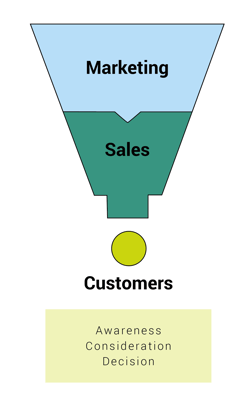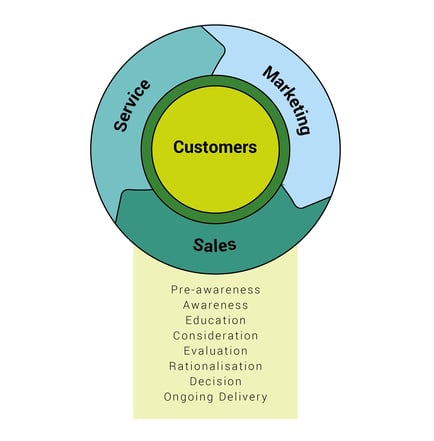There are so many buzzy terms in business these days! Now add to that list, the flywheel! The fly… what were my first thoughts!
Surely, business doesn’t need to be that hard. However, upon further investigation I started to see the merit in the flywheel analogy. Why?
Well for starters, marketing doesn’t work like it used to and that’s because people don’t buy like they used to. We’ve moved from a consumption mindset to and experience driven economy. In 2019 buyers are looking for experiences. They gravitate to those businesses that provide a great experience across the marketing, sales, and customer service cycle.
As we have seen in the recent Royal Commission into Banking and Finance, it’s no longer enough to generate a lead, sell them a product and not care about the performance and experience of using that product. Businesses need to engage with customers before, during and after the sale.
To achieve this, businesses need to think about replacing the marketing and sales funnel model with the flywheel model as shown below.


Linear processes like the marketing and sales funnel are easy to comprehend however, they don’t reflect how prospects, once they become customers, can help drive business growth. The flywheel approach, on the other hand, revolves around your customers and the ongoing value they provide.
An expanded and more comprehensive B2B buyers journey
The flywheel necessitates a more detailed and realistic buyers journey that aids businesses in their quest to accelerate their marketing, sales and service endeavours. Listed below are the segments in all their glory.
Pre-awareness
At the pre-awareness stage most businesses aren’t searching for businesses like yours. They probably do not even know your business exists and if they do, then you are not on their radar!
Yet, you know and understand that these businesses need the products, services and solutions you provide, they just don’t know it…yet.
The purpose of prospecting at the pre-awareness stage is to raise awareness and build new prospects. Leads and sales are for later. It’s about getting your businesses solutions out there so that the right people know your business exists in a way that is not salesy.
Awareness
All the good efforts in generating prospect leads is of little value if you can’t build an emotional connection with them by providing great value. The objective here is to get these new prospects to like you. This is a dating period and you need to be respectful as they are most likely not ready to make a purchase or talk to anyone from your business just yet.
However, these are your potential customers. And they have indicated that they are willing to receive information from you on their chosen pain or gain point at this stage, so it’s the perfect time for you to win them over.
Education
Our prospects at this stage buyers are actively researching and exploring the market for as many solutions as possible. These prospective customers still may not be ready to buy but are looking for reassurance and trust indicators so they can be 100% confident with the decision they make.
You need to up your game in terms of the quality of your content and also the reach of your content at this stage. This is the most competitive stage and need to cut through the clutter and connect emotionally.
Consideration
Your prospective customer is now firmly in buying mode and as such will be looking to evaluate competitive offers, features and benefits.
Your content needs to be especially clear and transparent so your buyers are left with a sound understanding as to why you should be the preferred choice. This content should also weed out potential ‘tire kickers’ at this stage.
Evaluation
So now we are getting to the pointy end and it’s likely that your buyer is short listing you with the competitive offers in the market. At this stage, its content like case studies, reviews, testimonials that are going prove persuasive for your buyer. They need to feel like you can solve their challenge.
Rationalisation
Your buyer now has a good idea as to the buying direction they are likely to head in however they need approval from colleagues and other stakeholders. There are also the finer details to work through such as payment and contract terms so they ensure minimal risk for their business.
What can you do at this point? Most likely they’ve emotionally committed to you at this stage so playing the role as their advocate is going to be helpful to the rationalisation of cost and resource allocation the require for a final decision.
Decision
As you can appreciate, with so many steps in the buyers journey it is not a linear process with some steps likely to be very quick or taking longer depending on the scenario.
By the time the decision stage comes around your buyer has selected the product or service they wish to proceed with and the finer details have been agreed to.
But it’s not over just yet… This stage is all about removing any friction in order to get that signature on a purchase order. You’ll want to train your sales staff on how to onboard a client in order to reduce any anxiety the client may have. All communication needs should be clear and definitely do not introduce new items at this late stage.
Ongoing delivery
Just making a sale isn’t good enough. Wouldn’t it be better to create a repeat ordering customer? So, you need to create an on-boarding process that doesn’t cut sales off in the fulfilment process – after all sales have built the relationship and not letting it decay is your goal here.
There are going to be ‘bumps’ along the way and you’ll need the relationship skills of sales to ensure the customer needs are front and centre. Aside from this you want to continue your marketing activities that are helpful and useful in nature – creating value beyond the product and or service.
Using the flywheel framework as your growth enabler
As stated right up front, I was thinking: Is this just more business jargon for the sake of it? No. If you have trouble with the word Flywheel, I understand and put it to an aside, perhaps consider it a whole of business approach to being customer-led. However, the flywheel analogy is powerful, when you envisage your business as a as more than just a funnel - you make more holistic decisions that are more like to create momentum and growth.
Taking the Flywheel analogy further, there are three factors that dictate how much momentum your flywheel generates:
- How fast you spin it → Attracting prospects via your content and conversations
- How much friction there is → Engaging through helpful insights and solutions
- How it’s composed → Delighting via a remarkable product experience
The Flywheel enables you to distil the core parts of your business, and bring focus on the most important activities at each stage.
How do we use the Flywheel at Collab?
Marketing: the ‘Attract’ phase – Provide value before extracting value
At Collab Agency, we are inbound marketing devotees, however you can also use traditional paid media channels to get your flywheel spinning as well. Using inbound marketing we aim to provide value before we extract value, so we invest heavily in free content through our weekly eDM campaigns, blogs, vlogs, workshops and social media advertising.
Sales: The ‘Engage’ phase – Make it easy to shop and buy
For those prospects outside our personal networks, it’s a big thing for them to reach out to us. The last thing they want, is to be sold to. So, to make it easy for prospects to engage with our agency and potentially purchase services, we offer free audits across marketing, website SEO performance and Marketing ROI. We do research into industry verticals (like financial services) and provide ‘free’ ideas that could stimulate growth. Plus, we also have a lot of self-assessment graders for topics like brand and sales enablement so users can try before they buy without getting pounced upon.
Service: The ‘Delight’ phase – Client success is our success
Our clients have access to our strategy team which offers a free CMO advisory service. We aim to collaboratively educate our clients and so each quarter we run a MasterClass in Digital Strategy which is available for clients to attend at substantial discount. We also facilitate our customers having their feedback heard through an online survey with each survey contributing to a charity fund for Opportunity International. And we have an online portal for all web development projects that allow clients to log and track tasks that they need completed.
So, while the flywheel is a ‘buzzy’ term, it represents a more holistic way to grow your sales. It encourages different functions to collaborate, so as to reduce friction and generate more momentum in your business. And isn’t that what we all want!





